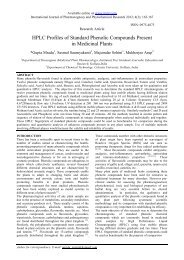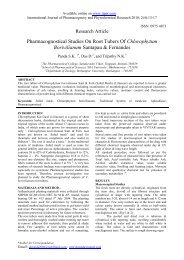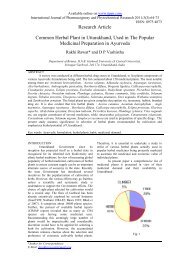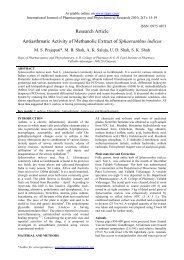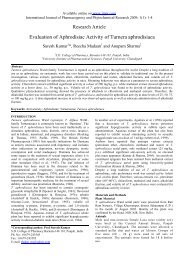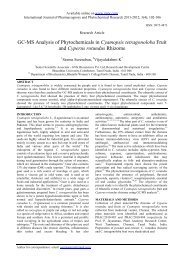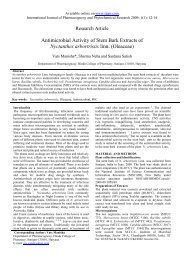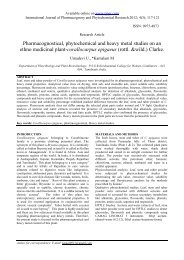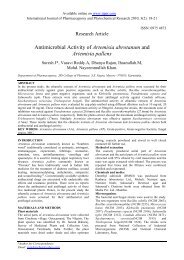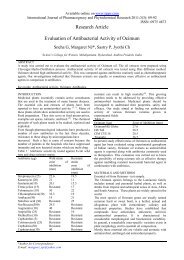phytochemical screening of the rhizome of kaempferia galanga
phytochemical screening of the rhizome of kaempferia galanga
phytochemical screening of the rhizome of kaempferia galanga
Create successful ePaper yourself
Turn your PDF publications into a flip-book with our unique Google optimized e-Paper software.
Rajendra et. al. / Phytochemical Screening <strong>of</strong>……<br />
Table 1: Phytochemical constituents <strong>of</strong> Petroleum e<strong>the</strong>r, Chlor<strong>of</strong>orm, methanol and water extracts <strong>of</strong> Kaempferia<br />
<strong>galanga</strong> <strong>rhizome</strong><br />
Sl.No. Test Pet e<strong>the</strong>r<br />
extract<br />
Chlor<strong>of</strong>orm extract Methanolic extract Water<br />
extract<br />
1 Sterols and triterpenoid + + + -<br />
2 Alkaloids - - + -<br />
3 Saponins - - - +<br />
4 Tannins - - - -<br />
5 Flavonoids - + + -<br />
6 Carbohydrates - - + +<br />
7 Resins + + + -<br />
8 Proteins - - + +<br />
Present (+); absent (-).<br />
Phytochemical Screening for all <strong>the</strong> extracts were<br />
performed using standard procedures.<br />
1. Test for Sterols and Triterpenoids: 25mg chlor<strong>of</strong>orm<br />
and methanolic extracts were dissolved in chlor<strong>of</strong>orm,<br />
filtered and filtrate was tested for sterols and<br />
Triterpenoids.<br />
a. Salkowski’s Test: Few drops <strong>of</strong> concentrated sulphuric<br />
acid were added to chlor<strong>of</strong>orm solution and observed for<br />
Red colour in lower layer for sterols and golden yellow<br />
colour indicates <strong>the</strong> presence <strong>of</strong> Triterpenoids.<br />
b. Libermann Buchard test: Few drops <strong>of</strong> acetic anhydride<br />
were added to chlor<strong>of</strong>orm solution, shaken well. 1ml <strong>of</strong><br />
concentrated sulphuric acid carefully added from sides <strong>of</strong><br />
<strong>the</strong> test tube. A reddish brown coloration indicates <strong>the</strong><br />
presence <strong>of</strong> sterols and Red ring indicates <strong>the</strong> presence <strong>of</strong><br />
Triterpenoids.<br />
2. Test for Alkaloids: 0.5g <strong>of</strong> extracts were diluted<br />
separately to 10ml with acid alcohol, boiled and filtered.<br />
To 5ml <strong>of</strong> <strong>the</strong> filtrate was added 2ml <strong>of</strong> dilute ammonia.<br />
5ml <strong>of</strong> chlor<strong>of</strong>orm was added and shaken gently to extract<br />
<strong>the</strong> alkaloid base. The chlor<strong>of</strong>orm layer was extracted<br />
with 10ml <strong>of</strong> acetic acid. These were divided in to 3<br />
portions.<br />
a. Dragendr<strong>of</strong>f’s Test: (Potassium Bismuth Nitrate): Few<br />
drops <strong>of</strong> Dragendr<strong>of</strong>f’s solution added to Chlor<strong>of</strong>orm<br />
solution, Reddish brown precipitate indicates <strong>the</strong> presence<br />
<strong>of</strong> alkaloids.<br />
b. Mayer’s Test: (Potassium Mercuric Iodide): Few drops<br />
<strong>of</strong> Mayer’s Reagent added to Chlor<strong>of</strong>orm solution,<br />
Creamy white precipitate indicated <strong>the</strong> presence <strong>of</strong><br />
alkaloids.<br />
c. Wagner’s Test: (Iodine in Potassium Iodide): Few<br />
drops <strong>of</strong> Wagner’s solution added to chlor<strong>of</strong>orm solution,<br />
Brown precipitate indicate <strong>the</strong> presence <strong>of</strong> alkaloids.<br />
3. Test for Saponins:<br />
a. Foam Test: To 0.5gm <strong>of</strong> extract was added 5ml <strong>of</strong><br />
distilled water in a test tube. The solution was shaken<br />
vigorously and observed for a stable persistent froth. The<br />
frothing was mixed with 3 drops <strong>of</strong> olive oil and shaken<br />
vigorously after which it was observed for <strong>the</strong> formation<br />
<strong>of</strong> an emulsion.<br />
b. Haemolysis Test: To 2ml <strong>of</strong> 1.8% Nacl solution taken<br />
in two test tubes, 2ml <strong>of</strong> distilled water added to one <strong>of</strong><br />
<strong>the</strong> test tube and 2ml <strong>of</strong> 1.0% extract was added to<br />
ano<strong>the</strong>r test tube, 5 drops <strong>of</strong> blood was added to each test<br />
tube and gently mixed <strong>the</strong> contents and observed under<br />
microscope. If haemolysis observed in <strong>the</strong> test tube<br />
containing <strong>the</strong> extract, it indicates <strong>the</strong> presence <strong>of</strong><br />
saponins.<br />
4. Test for Tannins:<br />
a. Ferric Chloride Test: About 0.5gm <strong>of</strong> <strong>the</strong> extract was<br />
boiled in 10ml <strong>of</strong> water in a test tube and <strong>the</strong>n filtered. A<br />
few drops <strong>of</strong> 0.1% ferric chloride was added and<br />
observed for brownish green or a blue-black coloration.<br />
b. Gelatin Test: Few ml <strong>of</strong> 1% solution <strong>of</strong> gelatin in 10%<br />
Sodium chloride was added to <strong>the</strong> above extract and<br />
observed for white precipitate indicates <strong>the</strong> presence <strong>of</strong><br />
Tannins.<br />
5. Test for Flavonoids: Three methods were used to test<br />
for flavonoids. First, few drops <strong>of</strong> 1% neutral ferric<br />
chloride to a portion <strong>of</strong> an aqueous filtrate <strong>of</strong> <strong>the</strong> extract.<br />
A blackish green coloration that produced on standing<br />
indicates <strong>the</strong> presence <strong>of</strong> flavonoids. Second, A few drops<br />
<strong>of</strong> 10% lead acetate solution were added to a portion <strong>of</strong><br />
<strong>the</strong> extract. A yellow precipitates indicates <strong>the</strong> presence<br />
<strong>of</strong> flavonoids. Third, a portion <strong>of</strong> <strong>the</strong> extract was<br />
dissolved in <strong>the</strong> methanol, to this a small piece <strong>of</strong><br />
magnesium ribbon was added, one ml <strong>of</strong> concentrated<br />
Hydrochloric added from <strong>the</strong> side <strong>of</strong> <strong>the</strong> test tube. A<br />
magenta colour indicates <strong>the</strong> presence <strong>of</strong> flavonoids.<br />
6. Test for carbohydrates: 100mg <strong>of</strong> methanolic and<br />
water extracts were dissolved in little quantity <strong>of</strong> distilled<br />
water and filtered. The filtrate was used to test <strong>the</strong><br />
presence <strong>of</strong> carbohydrates. There are four methods were<br />
used to test for carbohydrates.<br />
a. Fehling’s test: The filtrate was hydrolyzed with dil Hcl,<br />
neutralized with alkali and heated with Fehling’s solution<br />
A and B. The formation <strong>of</strong> Red precipitates indicates <strong>the</strong><br />
presence <strong>of</strong> reducing sugars.<br />
b. Barfoed’s test: Few ml <strong>of</strong> Barfoed’s reagent was added<br />
to <strong>the</strong> filtrate and boiled in a water bath. The formation<br />
<strong>of</strong> Reddish precipitates indicates <strong>the</strong> presence <strong>of</strong><br />
Monosaccharide.<br />
c. Molisch’s test: Few ml <strong>of</strong> Molisch’s reagent were<br />
added to <strong>the</strong> filtrate and concentrated sulphuric acid was<br />
added along <strong>the</strong> sides <strong>of</strong> <strong>the</strong> test tube. The formation <strong>of</strong><br />
Reddish violet ring indicates <strong>the</strong> presence <strong>of</strong><br />
Carbohydrates.<br />
IJPPR September - November 2011, Volume 3, Issue 3(61-63) 62



